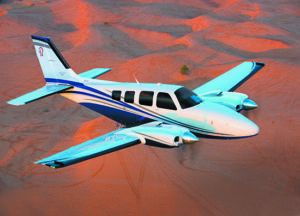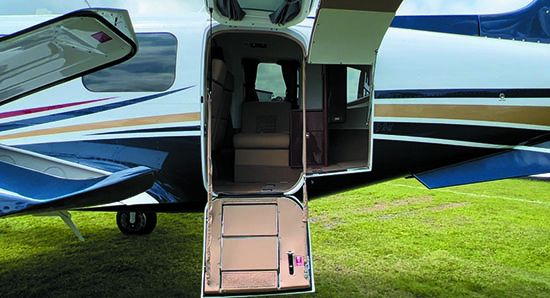If a Lock & Key Navajo isn’t in the budget, the good news is there are plenty of other twin-engine airplanes on the current market that are worth a look. For the past year and a half, we’ve watched prices of piston singles steadily inflate to levels never seen. And while well-cared-for and late-model light and medium-sized twins are up too, the used twin market is a touch softer, but not for newer ones. We’ll focus on non-pressurized models (for easier transition and maintenance)equipped with rear passenger/cargo doors for ease of loading. Lets go shopping, starting with used Navajos.
For this discussion, our launching point for referencing retail pricing is Aircraft Bluebook. The last of the Navajos to come off the line are the 1984 PA-31-350 Chieftains. The current Bluebook says the average retail price is $270,000. But looking closely at Bluebook’s appraisal points shows that the publication may again be lagging when it comes to current-day equipage. That $270,000 starting point is for ones with old King radios, and sure, many hard-working Navajos may still sport old avionics. But Bluebook says to add $1720 for an RMI. Come on, guys, ADFs and RMIs are boat anchors and nobody should add any money for them. Let’s go over to the respected Controller.com for another pricing reference.

We found a 1983 Chieftain in California listed for $295,000. The 5700-hour airplane was maintained on a Part 135 charter certificate, but the seller says it’s missing maintenance logbooks from 1983 to 2004. One Lycoming TIO-540 engine has 225 hours since a major overhaul in 2017 and the other has 325 hours since a major in 2008. For avionics, the airplane still has traditional flight instruments (King KCS55A electric HSI), the original King KFC200 autopilot and first-gen Garmin GNS navigators. An owner might invest we’ll north of $100,000 for a modern glass avionics upgrade with modern autopilot. A 1977 Chieftain Panther with mid-time engines with the latest Garmin panel including G600 TXi, Garmin EIS and dual GTN 750 navigators was listed for $525,000. It was cherry—with a modern paint scheme, luxurious cabin and no damage history—a good airplane in our estimation.
While we’re shopping for twins, let’s look at Beech Barons, and the G58 in particular. It won’t carry nearly as much as a Navajo, but you’ll spend roughly the same money for one as you would a Lock & Key refurb. There was a 2014 G58 in Florida advertised to be in “showroom” condition with 803 hours total time. The G58 Baron—equipped with Garmin G1000 integrated avionics—has Continental IO-550C engines with a 1900-hour TBO. The asking price for this airplane is $1.45 million. Oddly, Aircraft Bluebook says the average retail price is $950,000, and to add $29,000 for an NXi upgrade to Garmin’s G1000. Almost every other G58 we found listed was priced $1.25 million and higher. Earlier ones (mid-1980s) are priced we’ll north of $350,000.
Over in the Piper Seneca market, mid-2000 Seneca Vs were priced around $500,000 with modern Garmin retrofit avionics, although G1000 models came around the 2011 time frame. Bluebook says a 2014 Seneca V (these have Continental TSIO-360 turbocharged engines with a 1800-hour TBO) has an average retail price of $680,000, but these models sell for considerably more. Pre-G1000 airplanes had dual Avidyne Entegra integrated flight displays with Garmin GNS navigators and S-TEC autopilots. Pre-Avidyne airplanes had BendixKing radios and KFC-series autopilots. The earliest Seneca V was back in 1997, and Bluebook puts the typical retail price at $300,000, but ones with new avionics and other improvements sell for a premium.
Another twin worth considering is the Cessna 337 Skymaster. We covered it in the May 2022 Aviation Consumer Used Aircraft Guide. With centerline thrust, it might be an easy transition for first-time twin owners. Still, no matter which twin you consider, don’t bother getting too far into the shopping process without first getting an insurance quote. Expect higher rates than for a piston single at least initially, and specific training requirements.





